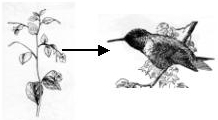Hummingbird Food Chains
Hummingbirds eat nectar from flowers, sap from trees, and tiny insects, spiders, and mites. Yet 100% of the energy they get comes from the sun. How can that be? It's because the plants they eat get all their energy from the sun . . .and the tiny animals that they eat get their energy from plants that get their energy from the sun.
Here's a simple hummingbird food chain that shows how energy is transferred from the sun to a Ruby-throated Hummingbird:
 |
This hummingbird is getting energy by eating nectar from this jewelweed plant, which got its energy from the sun. Every hummingbird food chain has at least two things, because hummingbirds cannot get energy directly from the sun.
The next hummingbird is getting its energy by drinking sap from an aspen tree.
 |
The hummingbird can't get the sap by itself. It needed a helper—a Yellow-bellied Sapsucker—to do the work of drilling holes in the bark. So the sapsucker is contributing energy to help the hummingbird get its energy. We don't show the sapsucker on the food chain because it's not transferring its energy directly to the hummingbird, but the spasucker plays an important role in getting energy to a hummingbird in the same way that cars play an important role in many Turkey Vulture food chains.
Now let's look at a longer chain. In this one, a hummingbird is eating an aphid that had been eating the leaves on a rose plant. Think about how the sun's energy goes from the plant into the aphid, and then from the aphid to the hummingbird.
 |
When people set out hummingbird feeders, the hummingbird is getting its energy from sugar, which came from sugar beet plants or sugar cane plants that got their energy from the sun. But some people set out another kind of feeder for hummingbirds: chunks of melon in a mesh bag. The hummingbirds don't eat the melons, but they do eat tiny little fruit flies, as you can see in the next food chain.
 |
Hummingbirds are often part of the food chains for predators. Look at this food chain:
 |
The hummingbird was getting nectar from a jewelweed plant when a big-mouth bass jumped out of the water and gulped it down. But then a snapping turtle came by and chomped down the bass. A year later, when the snapping turtle was waddling back to the water after laying her eggs, a big black bear came and ate it.
Here's another food chain:
 |
After this hummingbird ate, it was perched in a little shrub when a preying mantis seized it and ate it! Later, a garden spider ate the mantis. After than, a robin ate the spider, and then a hawk ate the robin.
Try This! Journaling Question
-
How many different hummingbird food chains can you come up with? Make a hummingbird food chain that includes an oriole! How about one that includes a Bald Eagle? See if you can make a food chain that inscludes hummingbird and at least 8 other animals and plants.


